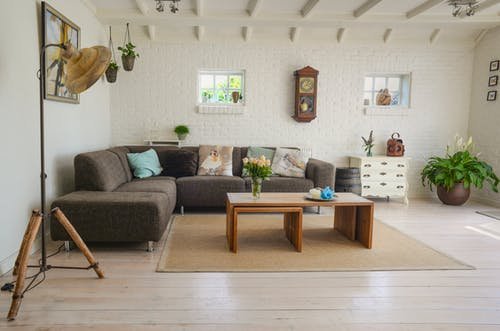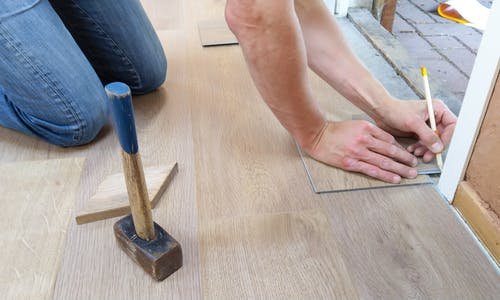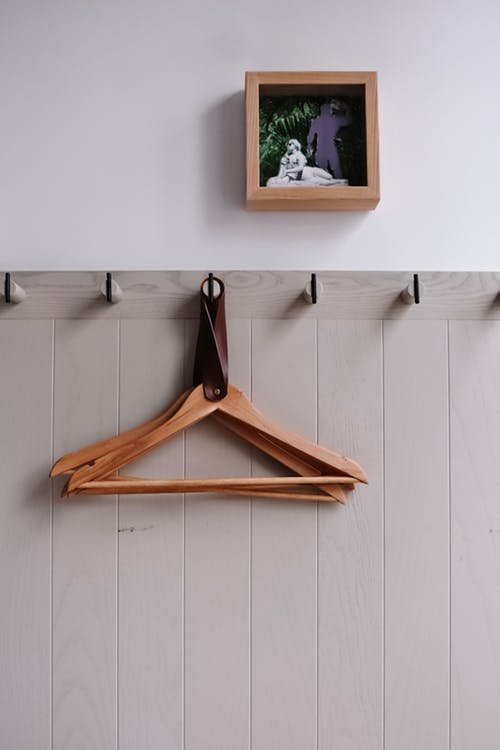REMODEL WITH NEW FLOORS AND WALLS
Changing wall and flooring finishes can make a huge impact on your home’s interior style. Floors and walls are often considered the canvas for the home’s interior design, and something that a visitor notices first. For anyone planning to renovate their home, the new flooring and wall retrofit should be the place to start. Here are some options you can exploit.
Laminate flooring
A synthetic flooring material that mimics the look of natural materials, laminate tiles are made of three layers: the bottom layer is highly resistant to moisture, the middle layer gives the strength of an inner core, and the top layer is designed in amazingly realistic patterns of wood grain, stones, metal, etc. With no special training and tools required, installation of laminate can be an easy DIY project, provided your subfloor is flat. Since this material is very resistant to damage, it’s suitable for homes with little kids and pets.
Stencils and projected images
Tape the stencil in place and paint the exposed areas with a fine paintbrush. The only costs of this project are the paintbrushes, paint and the stencil of choice. A package of paintbrushes won’t cost you more than $10 at a craft store, while stencils vary between $2 and $20. As you’ll be only painting in the design of the stencil, one gallon of paint will be enough. Alternatively, you can borrow a projector to project an image of your choice onto the wall, allowing you to mark the outlines of the image and paint inside the lines.
Wood flooring
Solid wood flooring has been considered a top choice for home interior renovations since time immemorial. While they aren’t cheap, hardwood floors add a lot of value to your home, both as an investment and aesthetically. Although susceptible to moisture, if sealed and treated properly, a wood floor can last for decades. When compared to carpets, regular brushing and vacuuming will keep it much more hygienic, while all the maintenance boils down to occasional polishing. Perhaps the greatest advantage in comparison with other options that if it becomes old and worn, instead of refitting a new floor you can simply refinish it at a fraction of the cost.
Decorative wall panels
With only a few scraps of trim, nails, and a nail gun, you can renovate your wall in an inexpensive way which looks amazing. While natural wood is a traditional choice, in countries like Australia, homeowners prefer more sustainable options like sheet panels, MDF, and hardboard, which come with increased resistance to heat and moisture. To maximise the effect of the new wall treatment, consult commercial carpentry contractor for their offer of timber feature mouldings and skirting that go with the wall panels you selected.
Vinyl flooring
As an artificial flooring material, vinyl is very resilient and economical, but vastly popular due to its versatility. Made with vinyl, felt, fibreglass, and dyes, vinyl flooring comes in sheets or tiles, which look like ceramic but are much cheaper and easier to install and replace. When compared to tiles, vinyl sheet is more durable and water-resistant. Their choice of colours and textures can match virtually any kind of décor. A lot of people confuse vinyl with linoleum, which is a 100% naturally sourced material but has properties similar to those of vinyl.
Wall fabrics
If your local craft store has a bargain bin, you'd be surprised how inexpensive some curtain panels on clearance can be. Fabrics for our purpose can be found as cheap as $1 per yard, while curtain panels start at $7 per panel. Spray starch on the wall to get the fabric to stick, and staple it using a staple gun. If you're renting the apartment and the landlord doesn't consent to any modifications like these, you can hang a long curtain rod on the wall near the ceiling and hang curtain panels from the rod so the wall is completely covered. This method won't damage the walls nor leave any residue behind.
The type of flooring and wall treatment you choose will depend on your budget as well as the requirements. For an apartment, a vinyl flooring and stencilled wall might be more suitable, where for a country house a solid wood floor and wall panelling with timber features would make a more permanent choice. if you need help you can always hire a professional renovation contractor.







